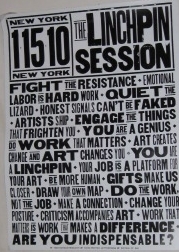
Image via Wikipedia
Email marketing lists get no respect. They’re the Rodney Dangerfield’s of marketing. Rodney’s signature “tag line” was “I don’t get no respect.”
Lists are a bit like that too, they’re a bit dull, and they have row after row of names and @ signs. None of it very interesting or flashy. Certainly not as fun as graphics (oooh pretty colors) or web design (buttons, clicking, interactive) or social media (more buttons – likes, dislikes, tweets).
Why you need a targeted email list
The truth is, your email list is the most important part of your marketing. A bad list equals bad results. If your list is performing poorly (and remember your house list is your best source of sales), it may be time for a bit of spring cleaning (or fall cleaning, depending on where you live).
Buying a list can be expensive, so the best thing to do is to build your own. Here are some tips to keep in mind when building (and maintaining) your email marketing list.
Size doesn’t matter
People get attached to the size of things, lists included. The size doesn’t matter. The quality, cleanliness (meaning it’s up to date and old addresses have been removed) and the responsiveness do. A big list won’t help if the data is old, the information is irrelevant, and nobody opens your mail.
Big can be bad
Don’t just take my word for it. Here’s the results of an actual case study from Marketing Sherpa (Nov. 9, 2010). The article describes what happened when The Indianapolis Symphony Orchestra decided to revamp its email marketing completely (samples and the full article here). The existing database had tens of thousands of names, but the marketing was hit-and-miss, irregular, and unfocused. The list was big, but it had a lot of old, outdated information – which meant that their mailings were getting a poor response.
Permission matters
Cleaning your list (and drastically reducing its size) can seem frightening. However, it also means that the only people on it want to be there. And, you’ll have fewer bounces, and less strain on your email server.
The Symphony sent a fresh email asking everyone on the list to confirm that they still wanted to receive emails. Anyone who didn’t answer was removed. Here’s the scary part. This cut the database by 95%!
Relevance matters
The next step was to ask people exactly what kinds of emails they wanted (or didn’t). So, those most interested in classical music would receive one newsletter, while people interested in events for children/families got another. The only content subscribers would get would be the content that they wanted to read.
Anticipated messages matter
The list was a lot smaller, but a lot better. I bet their open rates went way up too. Finally they started to build a new email list – adding an opt-in for ticket buyers, free ticket giveaways (opt-in option), and other outreach efforts. Instead of hit-or-miss, the emails were now welcome, relevant, and anticipated.
Responsiveness matters
The list has since grown by 500% and sales have doubled. Permission (check). Relevant (check). Anticipated (check)… even some respect.
(If you’re wondering, the tombstone reads, “There goes the neighborhood”)




 Trying to get attention without a big budget? It can be hard to stand out in a crowd with all the big agencies making big splashes with multi-million dollar budgets. Luckily, here in the 21st century, you don’t need a big media budget to get noticed. You just need some time and some patience.
Trying to get attention without a big budget? It can be hard to stand out in a crowd with all the big agencies making big splashes with multi-million dollar budgets. Luckily, here in the 21st century, you don’t need a big media budget to get noticed. You just need some time and some patience.